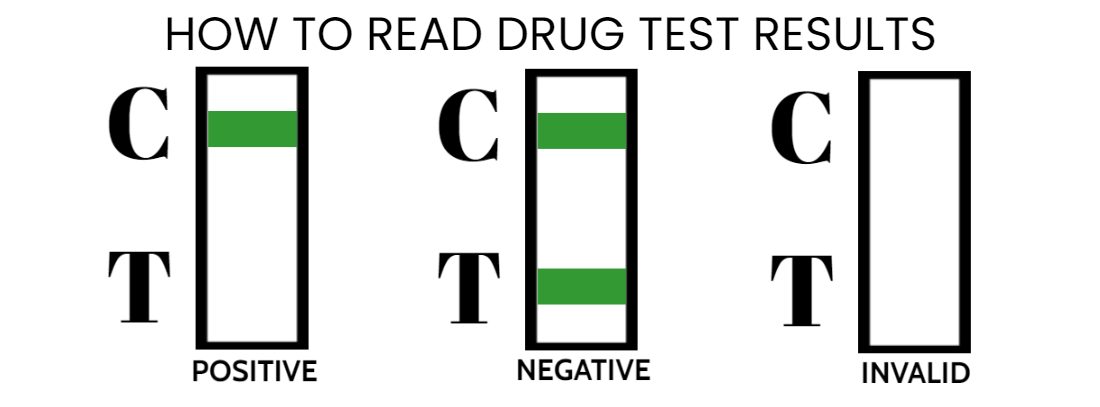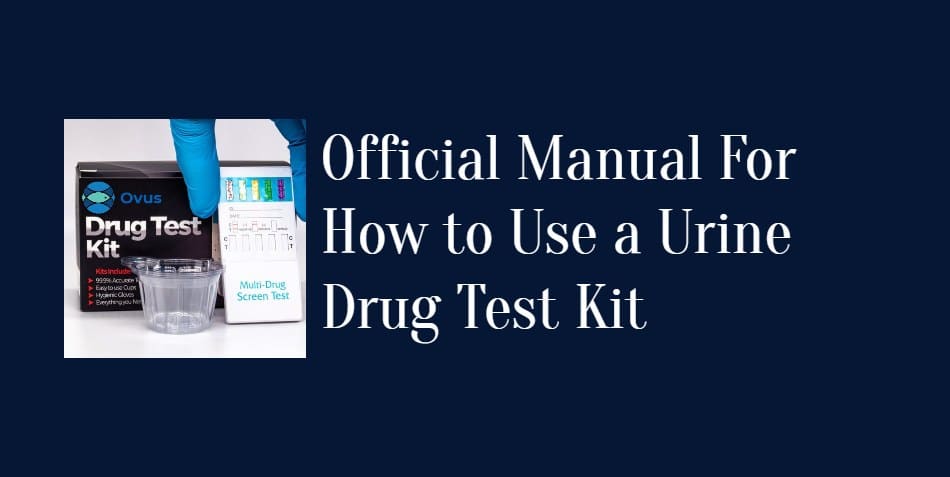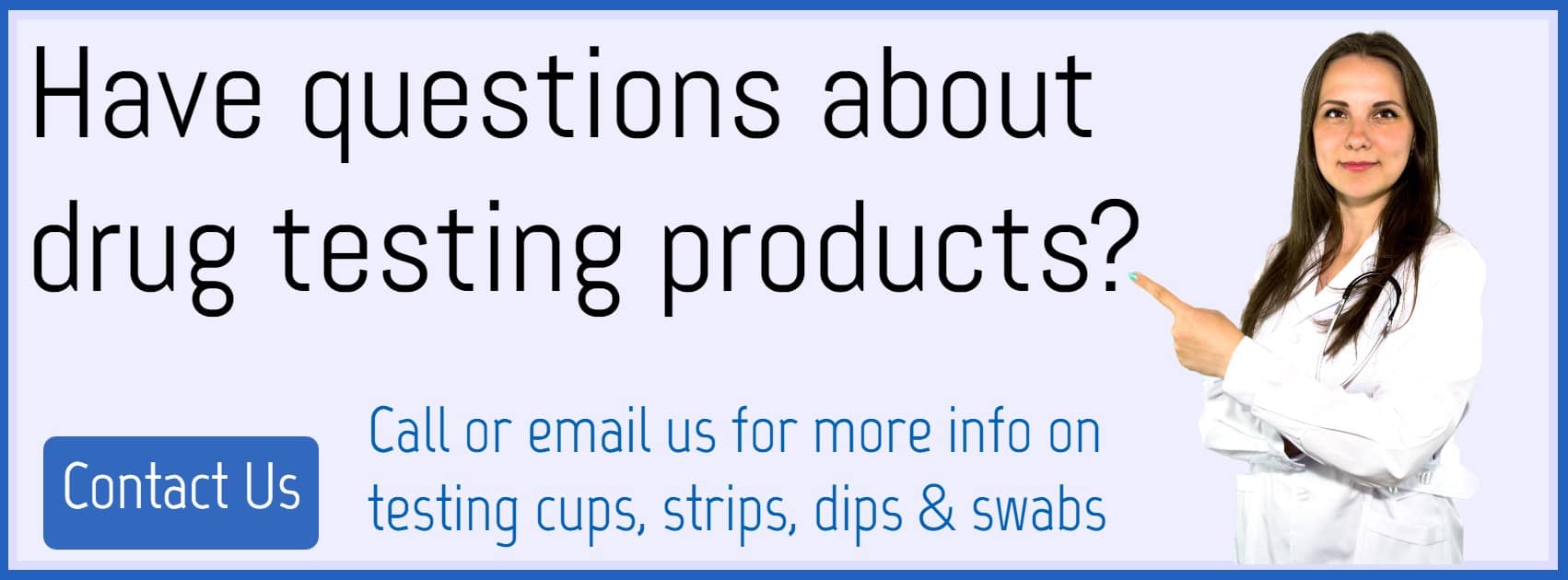When you are setting up an in-house program for workplace drug testing one of your first questions will likely be how to use a urine drug test kit. Official manual for Urine Drug Testing Kit for using a urine drug test dip card makes it easy to detect whether drugs are in a person’s system above the cutoff level noted on the drug testing kit instructions.
Substance abuse costs over $400 billion annually in crime, health, and lost work productivity in the United States. In 2016, of almost 9 million urine tests conducted for employers, 4.2% were positive. Seven out of every ten employers are affected by prescription drug abuse, with 217 on-the-job overdoses in 2016.
In a survey conducted by Detox, 1,121 professionals admitted to using drugs in the workplace. Opiates are the most common drug used at work, with Benzodiazepines coming in second and amphetamines third.
Most of the survey respondents use the drugs either on their way to work or during their lunch break. The car or parking lot is where 48.03% of users consume drugs, and another 18.4% use the bathroom. To get around workplace drug tests, 31.51% of survey respondents use detox drinks and 24.37% substitute their urine.
If you are planning to use drug testing kits in your place of business, this guide – Official manual for Urine Drug Testing Kit will provide you with everything you need to know to properly administer and read testing results.
Conducting the Test
Prior to conducting the test, ask your employee and make note of any over-the-counter or prescription medications they are taking. Those may impact test results. The employee should not drink excessive amounts of water prior to testing.
The person should urinate into the provided collection cup. Some employees tamper with collection samples. You may want to turn off the water in the bathroom and have blue dye in the toilet.
Make sure you follow the instructions on the kit for testing the urine within the proper time frame. You may also wish to review these videos on using drug testing strips and drug testing cups.
Keep a record of every test you administer. Your drug testing records should include the donor’s name, date, time, and reason for the test. Note the type of test, what substances the test checks for, the sample temperature, and test results.
Both the donor and administrator of the test need to sign the record to complete the process. Results should be kept in a secure location. You may provide a copy to the employee for their records.

Faint Line on a Drug Test
Understanding how to use a urine drug test kit includes knowing how to read the results. The intensity of a line on a dip card test has no bearing on the results. Test results are only positive or negative.
Any line, regardless of its intensity, indicates a negative test result. Negative results show a line in the control region (C) section of the strip and a line in the test region (T) section of the test. Two lines of any intensity indicate the test is negative for that drug.
On a multi-panel test, there will be a test section for each substance being tested. The results of a line of any intensity indicate a negative result.

A Negative Does Not Necessarily Mean No Drugs
When a person tests negative for a particular substance, it does not necessarily mean there is none of that substance in the person’s body. It means that any concentration of that substance in the person’s urine is below the designated cut-off level for that drug.
If you are administering drug testing kits for marijuana and the cut-off limit on the test is 50 ng/ml, a person with only 30 ng/ml of THC in their system will test negative. Detection levels in drug tests kits are based on the Substance Abuse and Mental Health Services Administration (SAMHSA) to prevent false positives for trace amounts of a substance.
Businesses using drug testing for employees use standard cut-off levels. Law enforcement, drug rehabilitation, and treatment centers use a lower cutoff level because of their zero-tolerance policy.
Positive Test Results
When the test has one line in the control region (C) and no line in the test region (T), this indicates a positive result. The positive result of a urine dip card test is a preliminary positive. The results need to be confirmed with a follow-up test in a lab.
A lab may find that an interfering substance in the person’s system other than the drug you are testing for. Lab testing may reveal substances causing a false positive.
The benefit to obtaining and knowing how to use a urine drug test kit is the cost-effectiveness of screening employees without the cost of laboratory testing. You only pay for laboratory testing to confirm positive test results.
Invalid Test Results
If no line appears in the control region (C) of the test, it is an invalid result. This may happen if there is insufficient urine or proper procedures were not followed.
Review testing instructions and repeat the test. If you receive an invalid result a second time contact the supplier of the test.
Multi-Panel Drug Test
The 10-panel screen is the most popular drug testing methods with employers. It is also used for monitoring the use of pain medication, sports testing of athletes, medical screening, and legal or forensic information.
Employers select the 10-panel urine dip card test to screen job applicants for drug use. It is also popular for random drug testing, testing employees suspected of drug abuse, or following a workplace accident. If the panel tests show positive you must confirm those results with a follow-up lab test.
How Long Do Drugs Show Up on a Urine Drug Test?
The length of time any substance remains in a person’s system depends on the frequency of use, body size, activity level, and other factors. While there is no guarantee on how short or long a person’s body will test positive for a substance, here is an estimation for popular drugs in a urine test.
- Amphetamine (AMP)—appears in 2-5 hours, disappears in 1-4 days
- Barbiturates (BAR)—appears in 2-5 hours, disappears in 4-7 days
- Benzodiazepines (BZO)—appears in 2-5 hours, disappears in 3-7 days
- Buprenorphine (BUP)—appears in 2-5 hours, disappears in 1-3 days
- Cocaine (COC)—appears in 2-5 hours, disappears in 1-3 days
- Ecstasy (MDMA)—appears in 2-5 hours, disappears in 1-3 days
- Fentanyl (FTY)—appears in 1-4 hours, disappears in 1-3 days
- Marijuana (THC)—appears in 2-5 hours, disappears in 3-30 days
- Methadone (MTD)—appears in 2-5 hours, disappears in 3-5 days
- Methamphetamine (mAMP)—appears in 25 hours, disappears in 3-5 days
- Opiates (OPI)—appears in 2-5 hours, disappears in 2-4 days
- Oxycodone (OXY)—appears in 205 hours, disappears in 2-4 days
- Phencyclidine (PCP)—appears in 205 hours, disappears in 7-14 days
- Tramadol (TRA)—appears in 8-12 hours, disappears in 3-7 days
Times may vary slightly from the above depending on the frequency of use and the actual drug used. For example, whether the opioid is heroin, codeine, morphine, methadone, or oxycodone.
Learning How to Use a Urine Drug Test Kit Is Easy
Learning the proper procedures on how to use a urine drug test kit is easy and saves money by not paying lab fees for routine screening.
At Ovus Medical you can shop our full line of urine testing dip cards. We offer a simple THC test dip card and panel screenings are available in everything from a 3-panel to a 13-panel urine dip drug test with fentanyl.
Shop our full line of products today. If you have any questions feel free to call us at 1-800-921-8241.
Buy Dip Card Tests Here


